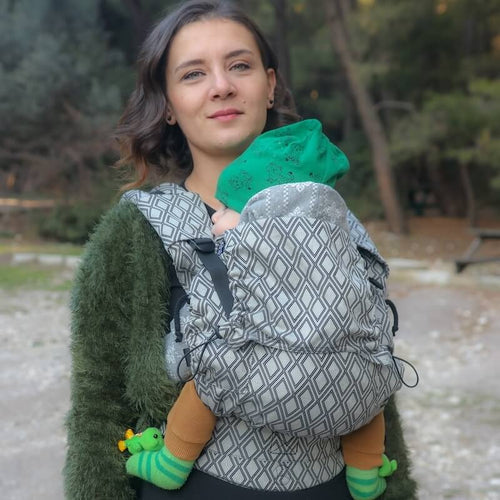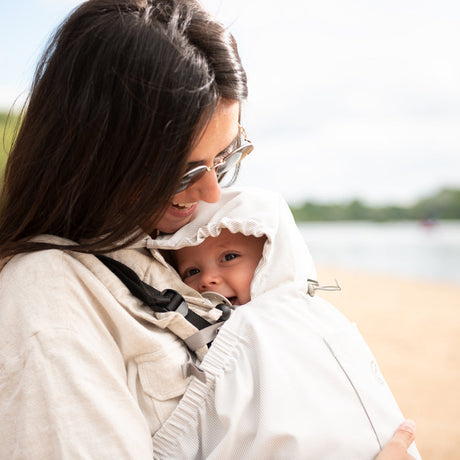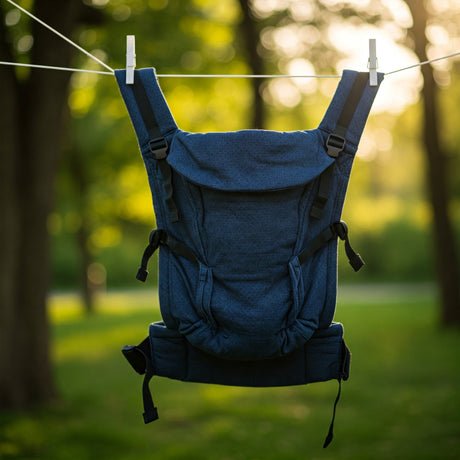When you see parents carrying their babies in carriers, it's heartwarming to witness the close bond and comfort shared. The sight of a baby nestled against a parent, legs pulled up and arms under the body, resembles the natural "frog" or "M" position. This position is not only adorable but also crucial for your baby's development. In this guide, we'll explore what ergonomic carrying means and how to ensure your baby is positioned correctly in a carrier.
What Does Ergonomic Carrying Mean?
An ergonomic baby carrier is designed to support both the caregiver and the child comfortably and safely. It promotes a natural position for the baby, ensuring healthy hip and spine development.
The M-Position (Frog Position):
The optimal carrying position is the M-position, where the baby's legs are slightly spread and pulled up high, with knees higher than the buttocks. This position supports the natural curvature of the baby's spine (C-shape) and is essential for healthy hip development.
Key Features of an Ergonomic Baby Carrier:
- M-Position: Legs slightly spread (30º) and raised (knees at the level of the navel), with the spine bent in a C-shape.
- Arms Together: The baby's arms are naturally positioned, not forced into the carrier.
- Head Support: Provides support for the baby's head during sleep and neck support while awake.
- Shoulder Support: Evenly distributes the baby's weight across both shoulders, hips, and back.
- Breathing Space: Allows space for two fingers between the baby's chin and the caregiver's chest, ensuring clear airways.
- Carrying Height: The ideal carrying height is when you can kiss your baby's head, promoting closeness and comfort.
Recognizing Incorrect Carrying Positions
An improper carrying position can lead to discomfort and potential health issues for both the baby and the caregiver. Signs of an incorrect position include:
- Legs fully spread (90º) or not raised.
- Knees below or at the level of the buttocks.
- Extended spine, not following the natural C-shape.
Benefits of Using an Ergonomic Baby Carrier
Proper ergonomic carrying offers numerous advantages:
For the Baby:
- Supports healthy hip and spine development.
- Promotes better breathing and digestion.
- Enhances emotional bonding and security.
For the Caregiver:
- Reduces strain on shoulders, neck, and back.
- Allows for hands-free activities.
- Facilitates breastfeeding on the go.
Choosing the Right Ergonomic Baby Carrier
When selecting an ergonomic baby carrier, consider the following:
- Adjustability: Ensure the carrier can be adjusted to fit both you and your baby comfortably.
- Support: Look for carriers that offer adequate support for the baby's hips, spine, and head.
- Comfort: Choose carriers with padded straps and breathable materials to enhance comfort for both you and your baby.
- Safety: Verify that the carrier meets safety standards and provides clear instructions for proper use.
At Babymaxi, we offer a curated selection of ergonomic baby carriers designed to meet these criteria, ensuring comfort and safety for both you and your baby.
Conclusion
Understanding and utilizing ergonomic baby carriers is essential for promoting your baby's health and enhancing the carrying experience. By choosing a carrier that supports the natural M-position and offers proper support, you can enjoy the numerous benefits of babywearing.
For a visual guide on properly using an ergonomic baby carrier by Isara, you might find the following video helpful:






